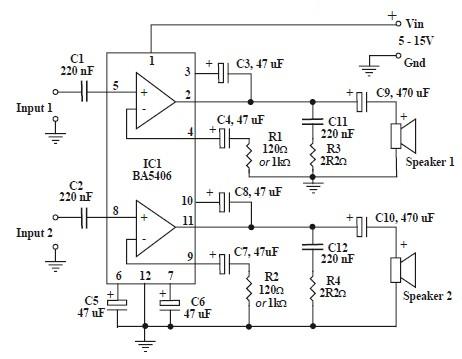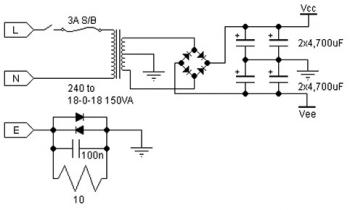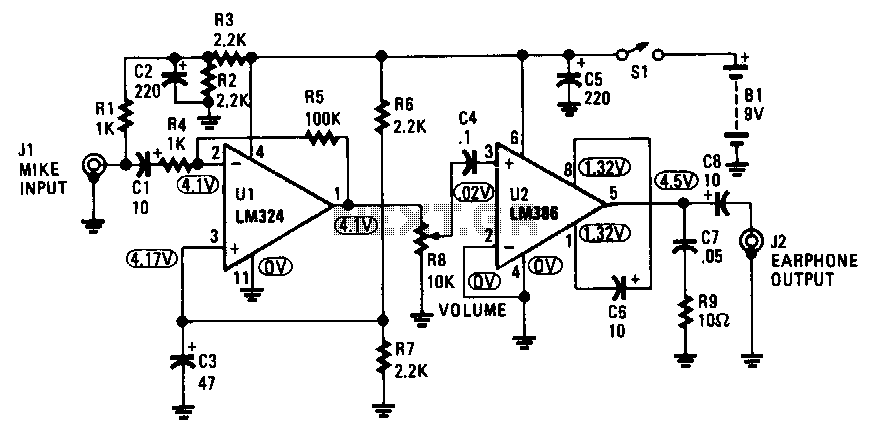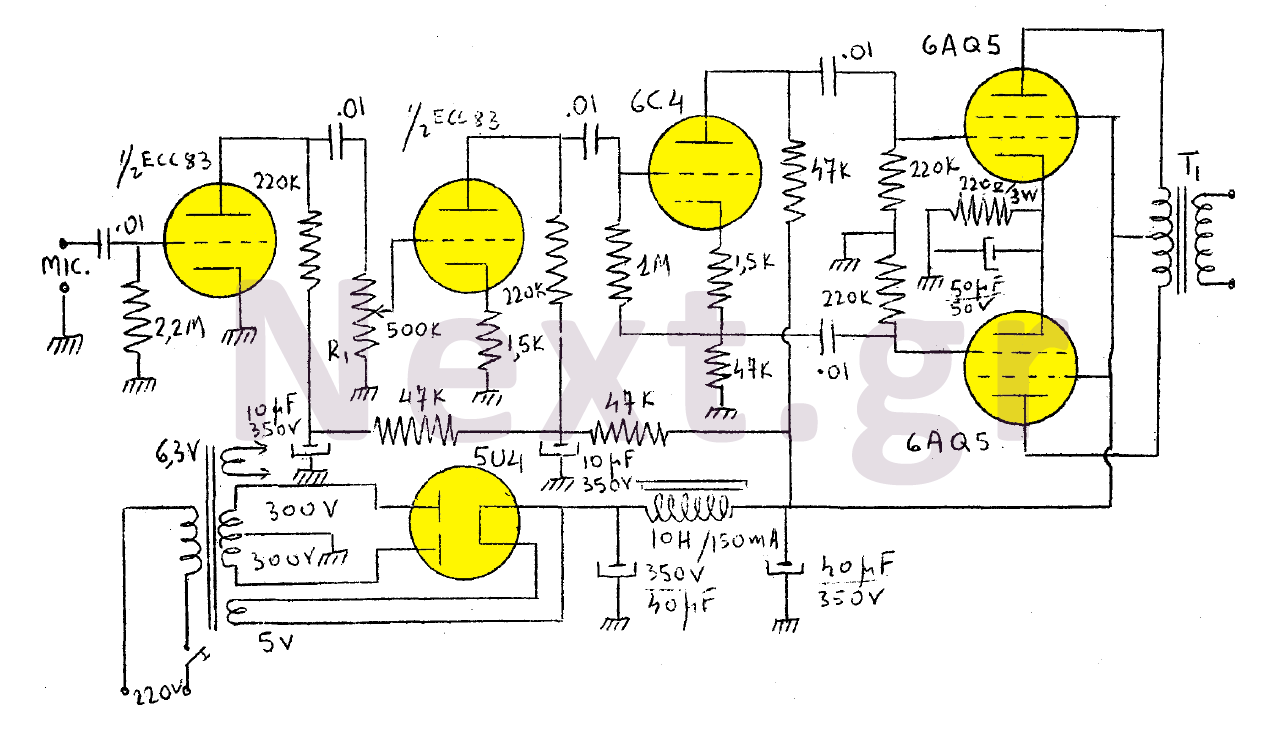
8W Amplifier Based on IC LM383
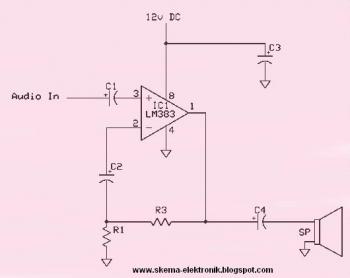
This circuit is an 8W audio amplifier utilizing the LM383 integrated circuit as its primary component. It is designed to be simple, cost-effective, and easy to assemble.
Component part list:
- C1: 10μF Electrolytic Capacitor
- C2: 470μF Electrolytic Capacitor
- C3: 0.1μF Disc Capacitor
- C4: 2000μF Electrolytic Capacitor
- R1: 2.2 Ohm Resistor (with a tolerance of ±10%)
- R3: 220 Ohm Resistor (with a tolerance of ±10%)
- IC1: LM383 Integrated Circuit
The 8W audio amplifier circuit based on the LM383 IC is designed to provide a compact and efficient solution for audio amplification needs. The LM383 is a power amplifier specifically designed for audio applications, capable of delivering a maximum output power of 8 watts.
The circuit is composed of several key components that work together to achieve the desired amplification. The capacitors (C1, C2, C3, and C4) serve various purposes, including filtering and coupling, ensuring that the audio signal is clean and free from noise. C1, with a value of 10μF, is typically used for input coupling, allowing the audio signal to pass while blocking any DC offset. C2, a larger 470μF capacitor, is used for power supply decoupling, stabilizing the voltage supplied to the LM383 and reducing the risk of oscillations. C3, a 0.1μF disc capacitor, is often used for high-frequency filtering, ensuring that unwanted high-frequency noise does not affect the audio output. C4, with a value of 2000μF, serves as the output coupling capacitor, allowing the amplified audio signal to pass to the speaker while blocking any DC component.
The resistors R1 and R3 are critical for setting the gain of the amplifier. R1, at 2.2 Ohms, is used to establish a feedback loop that controls the gain and stability of the amplifier. R3, at 220 Ohms, can be adjusted to fine-tune the gain and ensure optimal performance based on the specific application requirements.
The LM383 IC itself is a versatile component that simplifies the design of audio amplifiers. It features built-in thermal protection and short-circuit protection, enhancing the reliability and longevity of the amplifier circuit.
Overall, this circuit design is not only straightforward but also cost-effective, making it an excellent choice for hobbyists and professionals looking to create a reliable audio amplification solution. The careful selection of components ensures that the amplifier delivers quality audio performance in various applications, from small audio devices to larger sound systems.This is the 8W audio amplifier with IC LM383 as the main component. Very simple, easy and cheap circuit. Component part list: C1 - 10uf Electrolytic Capacitor C2 - 470uf Electrolytic Capacitor C3 - 0.1uF Disc Capacitor C4 - 2000uf Electrolytic Capacitor 2200uF R1 - 2.2 Ohm Resistance (Anything Within 10% tolerance) R3 - 220 Ohm Resistance (Anything Within 10% tolerance) IC1 - LM383 IC 🔗 External reference
Component part list:
- C1: 10μF Electrolytic Capacitor
- C2: 470μF Electrolytic Capacitor
- C3: 0.1μF Disc Capacitor
- C4: 2000μF Electrolytic Capacitor
- R1: 2.2 Ohm Resistor (with a tolerance of ±10%)
- R3: 220 Ohm Resistor (with a tolerance of ±10%)
- IC1: LM383 Integrated Circuit
The 8W audio amplifier circuit based on the LM383 IC is designed to provide a compact and efficient solution for audio amplification needs. The LM383 is a power amplifier specifically designed for audio applications, capable of delivering a maximum output power of 8 watts.
The circuit is composed of several key components that work together to achieve the desired amplification. The capacitors (C1, C2, C3, and C4) serve various purposes, including filtering and coupling, ensuring that the audio signal is clean and free from noise. C1, with a value of 10μF, is typically used for input coupling, allowing the audio signal to pass while blocking any DC offset. C2, a larger 470μF capacitor, is used for power supply decoupling, stabilizing the voltage supplied to the LM383 and reducing the risk of oscillations. C3, a 0.1μF disc capacitor, is often used for high-frequency filtering, ensuring that unwanted high-frequency noise does not affect the audio output. C4, with a value of 2000μF, serves as the output coupling capacitor, allowing the amplified audio signal to pass to the speaker while blocking any DC component.
The resistors R1 and R3 are critical for setting the gain of the amplifier. R1, at 2.2 Ohms, is used to establish a feedback loop that controls the gain and stability of the amplifier. R3, at 220 Ohms, can be adjusted to fine-tune the gain and ensure optimal performance based on the specific application requirements.
The LM383 IC itself is a versatile component that simplifies the design of audio amplifiers. It features built-in thermal protection and short-circuit protection, enhancing the reliability and longevity of the amplifier circuit.
Overall, this circuit design is not only straightforward but also cost-effective, making it an excellent choice for hobbyists and professionals looking to create a reliable audio amplification solution. The careful selection of components ensures that the amplifier delivers quality audio performance in various applications, from small audio devices to larger sound systems.This is the 8W audio amplifier with IC LM383 as the main component. Very simple, easy and cheap circuit. Component part list: C1 - 10uf Electrolytic Capacitor C2 - 470uf Electrolytic Capacitor C3 - 0.1uF Disc Capacitor C4 - 2000uf Electrolytic Capacitor 2200uF R1 - 2.2 Ohm Resistance (Anything Within 10% tolerance) R3 - 220 Ohm Resistance (Anything Within 10% tolerance) IC1 - LM383 IC 🔗 External reference

